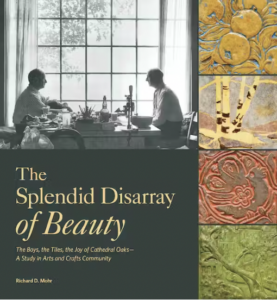In what turned out to be a rollicking interview on the podcast Wrote about my new book, The Splendid Disarray of Beauty, I spoke about two of the most interesting and admirable gay men most peoplehave probably never heard of until now: George Dennison (1873-1966) and Frank Ingerson (1879-1968), who, among their friends and community, were known as “the Boys,” and were a couple in life and love, a de facto common law marriage, for fifty-five years, all before Stonewall (1910-1966).
In 1911, as a honeymoon project, the largely self-taught artisans established a bohemian, summers-only art school in the eastern foothills of California’s Santa Cruz mountains, the first of its kind in the state. The school was widely influential, but lasted only four years. The men went on to lead a glamorous joint career in landscape and interior design, one that glittered across two continents, first in Santa Barbara and Hollywood ― they put the coconuts in the Coconut Grove ― then to Paris, London, and Rome, where they dined with the Peerage, painted in the Vatican Museums, and helped repair frescos in Italy.
They were life-long friends with many rich and famous people, in the arts and finance: Olivia de Havilland and Joan Fontaine, both of whom they drove to Hollywood for their big breakthroughs at age eighteen; Yehudi Menuhin, who the men took to the Louvre when he was eleven, and who, six years later, had his parents buy with his money the estate that wrapped around “the Boys’” property just above Los Gatos; Ruth St. Denis, who spent her 85th birthday with “the Boys;” the black Hollywood architect Paul Williams, who signed their guestbook with an architectural rendering; the philanthropist Amy Elizabeth DuPont; John D. Rockefeller, Jr., and on and on.
Dennison and Ingerson’s relationship was transparent to anyone who cared to look. Yehudi Menuhin’s nephew, whose mother used “the Boys” as a free extended-care babysitting service, reports: “My mother left me with “the Boys” for a couple of days, on more than one occasion — days that I loved. I knew “the Boys” were a ‘married’ couple, but I was never told to be afraid of them — and I wasn’t, and as it turned out, had no reason to be.”
“The Boys” were the center of a regional gay community that included the opera divinity Lotte Lehman and her partner and two local writers, Maude Meagher and Carolyn Smiley, who were jointly known as “the Girls.” They were also deeply engaged in their local culture more broadly, in their later years doing gobs of charity work for summer stock, regional theatre, and local historical pageants, executing set, costume, even landscape designs, with George occasionally treading the boards in minor roles.
Since none of their own projects ― their school and art works – gained for them the international stardom of their famous friends, after their deaths in the late 1960s, they drop into cultural oblivion. The interview and book retrieve “the Boys” and their beautiful and bounteous life together from starlessness.
You can listen to the full episode here. Also, make sure to check out Michael Quinn’s review of The Splendid Disarray of Beauty, available now in The G&LR‘s September-October 2023 issue.
Richard D. Mohr is Professor Emeritus of Philosophy and of the Classics at the University of Illinois at Urbana. His books on LGBTQ issues are Gays/Justice: A Study of Ethics, Society, and Law (Columbia UP, 1988), Gay Ideas: Outing and Other Controversies (Beacon, 1992), A More Perfect Union: Why America Must Stand Up for Gay Rights (Beacon, 1994), The Long Arc of Justice: Lesbian and Gay Marriage, Equality, and Rights (Columbia UP, 2005), and The Splendid Disarray of Beauty: The Boys, the Tiles, the Joy of Cathedral Oaks (RIT Press, 2023). In 1989, he founded and then served as the first general editor of Columbia University Press’ LGBTQ book series, Between Women ͂ Between Men. He and his hubby of 46 years live in Urbana, Illinois.






